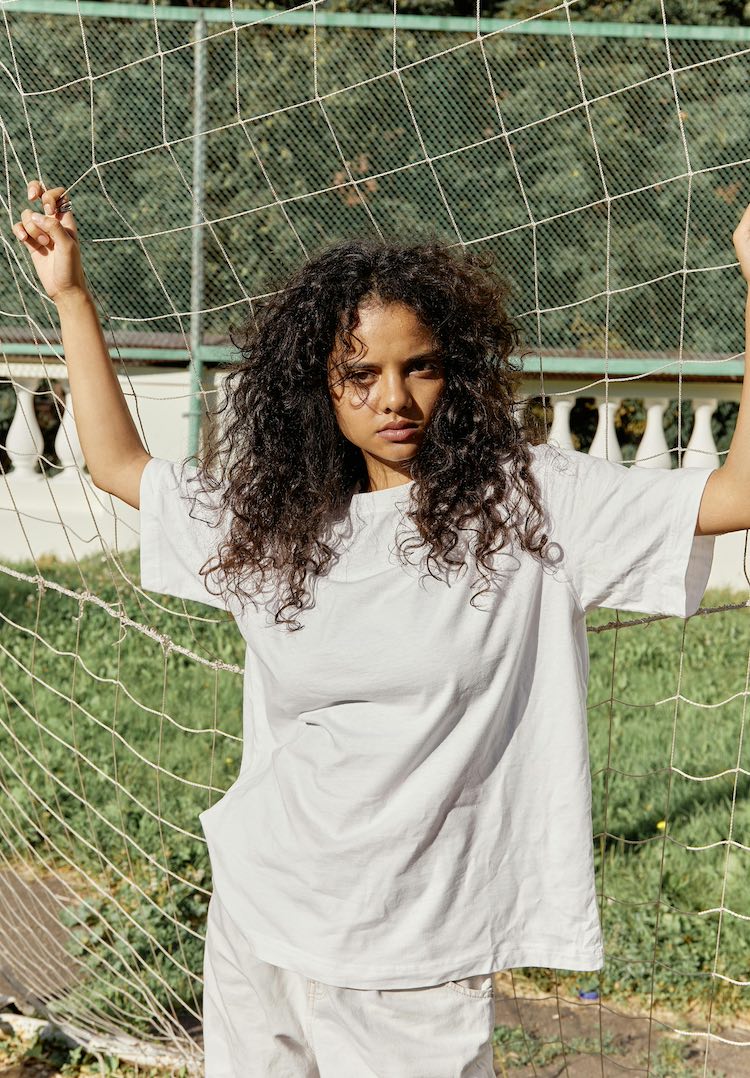
A white T-shirt is easily the most versatile building block of any wardrobe. In fact, I think you’d be hard-pressed to find someone who doesn’t own one and have it on regular rotation.
But walk down most shopping strips and the amount you can spend on a plain, white T-shirt can vary significantly. At one end of the spectrum, premium labels have crew necks on offer for up to $200, while at the other end, you can pick one up for as little as $2.50.
For more fashion news, shoots, articles and features, head to our Fashion section.
Often, we justify high price tags by rationalising that more expensive means better quality, longer lasting and sustainably made. But just how true is that? I’ve spent over $100 on cotton T-shirts that have quickly discoloured and pilled, while my cheaper alternatives look as good as they did when I first bought them, despite being over a year old.
I also tend to be far more impulsive with cheaper clothes. It takes less mental math and less justification when buying, and I’m admittedly far less conscious of taking care of less expensive pieces than I am compared to items I’ve had to save up for. In those instances, care seems to be the biggest indicator of how long a piece of clothing will last.
When holding up an expensive and cheap cotton T-shirt to the light, what exactly are the main differences? Is it quality? Longevity? A transparent supply chain? To find out, I spoke to Dr Carolina Quintero Rodriguez, a Senior Lecturer and Program Manager of the Bachelor of Fashion program at RMIT University.
What are the visible differences between a high-end and low-end cotton T-shirt?
Dr Rodriguez says that when comparing expensive, high-end and locally made cotton T-shirts with cheaper, mass-market options, the differences might be more subtle than expected (aside from packaging and branding).
“High-end white T-shirts generally feature heavier weights and premium cotton fibres, offering enhanced softness and strength, though these improvements might not be immediately apparent,” she explains.
Instead, Dr Rodriguez points out that the visible differences often lie in the trims and finishing details. “High-end and local manufacturers typically use higher stitch counts and stronger seam types.”
Along with better-quality threads, she explains that smaller production runs often allow for more attention to detail and more rigorous inspection processes. “However, it’s important to note that craftsmanship can vary significantly, even within price categories. The manufacturing of a T-shirt is extremely labour-intensive.”
Although most T-shirts are made from cotton, the quality can vary drastically depending on how exactly it’s grown. Agricultural practices make a big difference – from irrigation (the process of watering it), to fertiliser use and how it’s harvested. “Different regions with varying climates and soil conditions influence the fibre’s performance and, consequently, the fabric’s quality,” Dr Rodriguez adds.
The ‘ethics’ of expensive clothing
“High-end labels aren’t automatically more ethical than their lower-priced counterparts,” Dr Rodriguez tells me, immediately squashing most misconceptions that typically come with a high price tag. Typically, locally-made labels show a stronger commitment to reducing their environmental impact by prioritising local sourcing and manufacturing.
“Local manufacturers often maintain more transparent supply chains and direct relationships with their suppliers, while high-end brands typically have greater resources for implementing sustainable practices, she says. “The key difference often lies in scale and approach, with local brands frequently emphasising community connection and direct oversight of production processes.”
When comparing a high-end Australian label to a mass-market or fast fashion store, Dr Rodriguez says the differences lie in approach and scale. For example, high-end labels tend to invest in higher-quality fibres. They also tend to work with smaller and more easily traceable supply chains, and prioritise Australian or New Zealand-grown cotton. “In contrast, mass-market retailers typically operate with larger, more complex supply chains focused on volume and cost efficiency.”
The environmental impact also varies. Brands that keep their production local also tend to contribute to lower transport emissions and smaller production runs often create less waste. However, Dr Rodriguez says that the environmental impact extends beyond where clothing is made. Other elements like how much water is used, what chemicals are used to treat fabrics and waste management practices all play important roles.
The lifespan of a T-shirt
The lifespan of a white cotton T-shirt depends on a range of factors. Although high-end clothes might be better made, Dr Rodriguez explains that care and maintenance are equally important.
“Higher-end shirts typically maintain their shape better due to superior construction and may retain their whiteness longer, but these advantages can be reduced by improper care,” she tells me. In short, using and abusing your T-shirt is going to ruin the quality, no matter how expensive it was.
So, how do local designers typically land at higher price points?
Higher prices aren’t purely based on quality. Other factors like higher domestic labour costs, smaller production runs, rigorous quality control processes and having direct oversight of production all contribute to a garment’s price tag.
When weighing up high-end, locally made and mass-market white options, there are a few factors to keep in mind that go beyond packaging and branding.
According to Carolina, this can include how often you’re likely to wear the item, it’s care requirements and whether you can realistically follow them, the garment’s environmental impact, your own budget, your fit preferences (local makers often offer more customisation), and the importance you might place on supply chain transparency.
Rather than assuming price guarantees quality, it’s always better to go one step further and look into the label’s practices, where it gets its cotton, its labour practices and how willing it is to share details about its supply chain.
For more on finding the perfect T-shirt, head here.
This article What’s the real difference between a high-end and low-end plain white T-shirt? appeared first on Fashion Journal.
2025-05-01 09:30:00
#Whats #real #difference #highend #lowend #plain #white #Tshirt
Source link
















